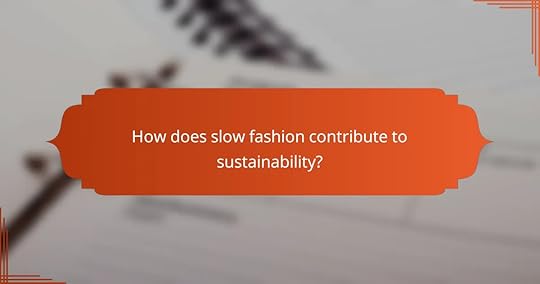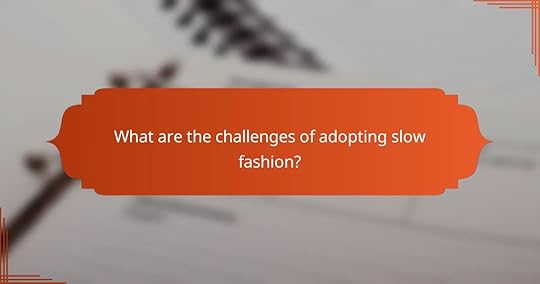Slow Fashion: Impact on Choices, Values and Sustainability
Slow fashion is reshaping consumer behavior by encouraging a thoughtful and intentional approach to clothing purchases. By emphasizing sustainability, ethical labor practices, and timeless design, it inspires individuals to make choices that positively impact both the environment and society. This movement prioritizes quality over quantity, fostering responsible consumption and reducing waste in the fashion industry.

Slow fashion significantly influences consumer choices by promoting a mindful approach to clothing purchases. It encourages individuals to consider the environmental and social implications of their fashion decisions, leading to more deliberate and informed buying habits.
Increased awareness of sustainabilitySlow fashion fosters a heightened awareness of sustainability among consumers. This movement emphasizes the environmental impact of clothing production, urging shoppers to seek out sustainable materials and practices.
As a result, many consumers now prioritize brands that utilize eco-friendly fabrics, reduce waste, and implement ethical manufacturing processes. This shift often leads to a preference for local and small-scale production over mass-market options.
Preference for ethical brandsConsumers influenced by slow fashion increasingly favor ethical brands that align with their values. These brands often prioritize fair labor practices, transparency in sourcing, and community engagement.
Shoppers are more likely to support companies that provide information about their supply chains and demonstrate a commitment to social responsibility, even if it means paying a premium for their products.
Shift towards quality over quantitySlow fashion encourages a shift from quantity to quality in consumer purchases. Instead of buying numerous low-cost items, consumers are now more inclined to invest in fewer, higher-quality pieces that offer durability and timeless style.
This change not only reduces waste but also promotes a more thoughtful wardrobe, where each item is chosen for its longevity and versatility. Shoppers are advised to consider the craftsmanship and materials of garments, ensuring they make purchases that will last.

The slow fashion movement is driven by values that prioritize sustainability, ethical labor practices, and timeless design. These principles encourage consumers to make thoughtful choices that positively impact the environment and society.
Commitment to environmental sustainabilityEnvironmental sustainability in slow fashion focuses on reducing waste and minimizing the carbon footprint of clothing production. Brands often use organic materials, eco-friendly dyes, and sustainable manufacturing processes to lessen their impact on the planet.
Consumers can support this commitment by choosing brands that prioritize sustainable practices, such as those that offer clothing made from recycled materials or those that implement take-back programs to recycle old garments. Look for certifications like GOTS (Global Organic Textile Standard) or OEKO-TEX to ensure environmental responsibility.
Support for fair labor practicesFair labor practices are essential to the slow fashion movement, ensuring that workers receive fair wages and safe working conditions. This value promotes transparency in the supply chain, encouraging brands to disclose where and how their products are made.
When shopping, consider brands that are certified by organizations like Fair Trade or those that provide information about their labor practices. Supporting local artisans and small-scale producers can also contribute to fair labor practices, as it often leads to better working conditions and economic stability in communities.
Emphasis on timeless designTimeless design in slow fashion emphasizes creating clothing that transcends trends, promoting longevity and versatility. This approach encourages consumers to invest in high-quality pieces that can be worn across seasons and occasions, reducing the need for frequent purchases.
To embrace timeless design, look for classic silhouettes and neutral colors that can be easily mixed and matched. Avoid fast fashion trends that quickly go out of style, and consider building a capsule wardrobe with versatile staples that reflect your personal style while supporting sustainable practices.

Slow fashion contributes to sustainability by emphasizing quality over quantity, which leads to reduced environmental impact. By prioritizing ethical production practices and long-lasting garments, slow fashion minimizes waste and promotes a more responsible consumption model.
Reduction of waste in the fashion industrySlow fashion significantly reduces waste in the fashion industry by encouraging consumers to buy fewer, higher-quality items. This approach contrasts with fast fashion, which often results in discarded clothing due to poor quality and rapid trends.
Brands that adopt slow fashion principles often implement strategies such as made-to-order production and limited collections, which help to minimize overproduction. For example, a brand might produce only a small batch of a particular design, ensuring that each piece is sold and utilized.
Use of eco-friendly materialsUsing eco-friendly materials is a cornerstone of slow fashion, as it prioritizes sustainable fabrics like organic cotton, hemp, and recycled materials. These alternatives typically have a lower environmental footprint compared to conventional textiles, which often rely on harmful pesticides and non-renewable resources.
Consumers can look for certifications such as GOTS (Global Organic Textile Standard) or OEKO-TEX, which indicate that the materials meet specific environmental and social criteria. Choosing garments made from these materials supports sustainable practices and reduces the overall impact on the planet.
Promotion of circular economy practicesSlow fashion promotes circular economy practices by encouraging the reuse, repair, and recycling of clothing. This model aims to extend the lifecycle of garments, reducing the need for new resources and minimizing waste.
Brands may offer repair services or take-back programs, allowing customers to return old items for recycling or refurbishment. By participating in these initiatives, consumers can contribute to a more sustainable fashion ecosystem and reduce their overall environmental impact.

Adopting slow fashion presents several challenges that can deter consumers from making sustainable choices. These include higher costs, limited product availability, and common misconceptions about what slow fashion entails.
Higher price points for consumersOne significant challenge of slow fashion is the higher price point compared to fast fashion. This is often due to the use of quality materials, ethical labor practices, and sustainable production methods. Consumers may find that investing in a few high-quality pieces is more cost-effective in the long run, as these items tend to last longer than cheaper alternatives.
For example, a well-made garment from a slow fashion brand might cost between $100 to $300, while a similar item from a fast fashion retailer could be priced under $50. This initial investment can be a barrier for many, but it aligns with the values of sustainability and ethical consumption.
Limited availability of productsSlow fashion brands often produce limited quantities of their items, which can make finding specific products challenging. This scarcity can lead to frustration for consumers who prefer a wider selection or immediate availability. Unlike fast fashion, which churns out new styles frequently, slow fashion focuses on timeless designs that may not always be in stock.
Shoppers may need to plan ahead and be patient, as popular items can sell out quickly. Joining mailing lists or following brands on social media can help consumers stay informed about restocks and new releases.
Consumer misconceptions about slow fashionMany consumers hold misconceptions about slow fashion, believing it to be overly expensive or limited to niche markets. This misunderstanding can prevent them from exploring sustainable options that fit their lifestyle. In reality, slow fashion encompasses a wide range of styles and price points, making it accessible to various demographics.
Education is key to overcoming these misconceptions. Consumers should research brands and their practices, as many slow fashion companies offer affordable options without compromising on ethics or quality. Engaging with communities focused on sustainable living can also provide valuable insights and support.

Consumers can support slow fashion brands by making intentional purchasing decisions that prioritize sustainability, quality, and ethical practices. This involves choosing brands that align with these values and actively participating in community-driven initiatives.
Choosing sustainable clothing optionsWhen selecting clothing, opt for items made from organic or recycled materials, which have a lower environmental impact. Look for certifications such as GOTS (Global Organic Textile Standard) or OEKO-TEX, which indicate adherence to sustainability standards.
Consider the longevity of the garments; investing in higher-quality pieces that last longer can reduce overall consumption. Aim for versatile items that can be mixed and matched, minimizing the need for excessive purchases.
Participating in clothing swapsClothing swaps are a practical way to refresh your wardrobe without buying new items. Organize or join local events where participants exchange gently used clothing, promoting a circular economy and reducing waste.
These swaps not only save money but also foster community connections. Check local social media groups or community centers for upcoming events, and consider hosting your own swap to engage friends and neighbors.
Supporting local artisans and designersBuying from local artisans and designers helps sustain local economies and promotes unique, handcrafted items. Seek out local markets, boutiques, or online platforms that feature these creators, ensuring your purchases support ethical practices.
Engaging with local fashion events or workshops can deepen your understanding of the craftsmanship involved. This not only enhances your appreciation for the items but also strengthens community ties and supports sustainable practices in your area.



